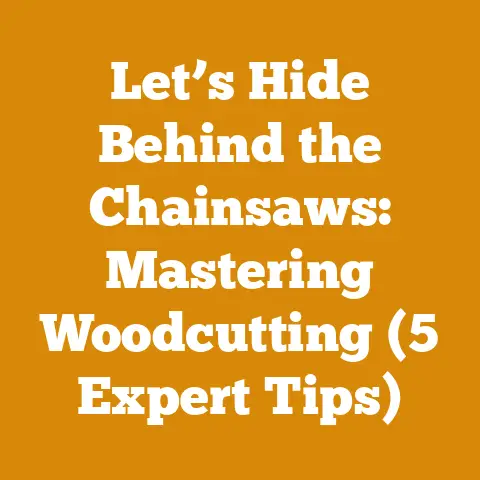Average Cost of Stump Grinding: Pricing Tips for Wood Pros (Insider Guide)
Ah, springtime. The birds are singing, the flowers are blooming… and I’m reaching for the antihistamines. Yes, allergies are a constant companion, but they also remind me of the cycle of life, death, and, well, stumps. Because let’s face it, those stubborn remnants of felled trees are the bane of many a homeowner and wood professional alike.
Now, you might be wondering what my seasonal sniffles have to do with stump grinding. Bear with me. Just like managing allergies requires understanding the triggers and applying the right remedies, tackling stump removal demands knowledge and a strategic approach. And that’s what I’m here to share with you today.
I’ve spent years in the wood processing and firewood preparation world, from felling trees in the biting winter wind to splitting logs under the scorching summer sun. I’ve seen it all – the good, the bad, and the downright stumpy. I’ve learned valuable lessons along the way, often through trial and error (and a few near misses with a chainsaw, I confess). So, consider this your insider guide, packed with practical advice, real-world examples, and maybe even a few humorous anecdotes to keep you awake. Let’s get grinding!
Average Cost of Stump Grinding: Pricing Tips for Wood Pros (Insider Guide)
Stump grinding is a necessary evil, a vital step in land clearing, landscaping, and even firewood preparation. While it might seem straightforward, accurately pricing stump grinding jobs requires understanding various factors. Let’s dive into the nitty-gritty.
Understanding the Factors Influencing Stump Grinding Costs
As with any service, several elements impact the final cost of stump grinding. Knowing these factors is crucial for accurate quoting and profitability. I’ve been caught out before underestimating the time it would take to grind a massive oak stump, and let me tell you, eating those costs isn’t a pleasant experience.
- Stump Size: This is the most obvious factor. Larger stumps require more time and effort to grind down. The diameter is usually measured at ground level. I’ve found that adding a quick sketch of the stump with dimensions helps me remember the specifics when I’m back in the office preparing the quote.
- Stump Quantity: Grinding multiple stumps at the same location often allows for economies of scale. You can offer a discounted rate per stump when handling multiple removals. One time, I was hired to grind 20 small stumps in a recently cleared lot. I offered a package deal that was attractive to the client and still profitable for me because I minimized setup and travel time.
- Stump Type: Different tree species have different wood densities. Hardwoods like oak and maple take significantly longer to grind than softwoods like pine or poplar. I once underestimated the grinding time for a black walnut stump because I hadn’t factored in its exceptional hardness. Lesson learned!
- Stump Location and Accessibility: Stumps in easily accessible areas are much easier (and cheaper) to grind. Stumps located in tight spaces, on slopes, or behind fences require more maneuvering and setup time. I remember a job where I had to use a crane to lift my stump grinder over a wall to reach a stump in a backyard. The extra equipment and labor significantly increased the cost.
- Stump Age and Condition: Older, decaying stumps can be easier to grind than fresh, solid ones. However, decaying stumps might also harbor pests or diseases that require special handling. Sometimes, you’ll find that an old stump has partially rotted, but the remaining wood is incredibly dense and hard to grind.
- Root System: The extent of the root system plays a significant role. Stumps with extensive, shallow roots are generally easier to grind than those with deep, taproot systems. Sometimes, the roots extend far beyond the visible stump, and you need to factor in the time it takes to chase them down.
- Soil Conditions: Rocky or sandy soil can dull grinder teeth quickly, increasing the time and cost of the job. The presence of rocks also poses a safety hazard. I always carry extra grinder teeth and a sharpening kit in my truck, just in case.
- Obstacles: Underground utilities, sprinkler systems, and buried objects can complicate the grinding process. Always call 811 (in the US) or your local equivalent to locate underground utilities before starting any grinding work. Trust me, hitting a gas line is not a good way to start your day.
- Cleanup and Disposal: The cost of cleaning up the ground-up wood chips and disposing of them (if necessary) should be factored into the price. Some clients want the chips left on-site as mulch, while others want them hauled away. Be sure to clarify this upfront.
Pricing Models: Choosing the Right Approach for Your Business
Several pricing models can be used for stump grinding, each with its own advantages and disadvantages. The best approach depends on your business model, target market, and local competition.
- Per-Stump Pricing: This is the most common pricing model. You charge a fixed price per stump, based on its size and other factors. This model is simple and easy to understand for both you and the client. I usually have a base price for small stumps (under 12 inches in diameter) and then increase the price based on size and complexity.
- Hourly Rate: You charge an hourly rate for your time and equipment. This model is best suited for complex jobs where the grinding time is difficult to estimate. I use an hourly rate when dealing with multiple stumps of varying sizes and complexities, or when I anticipate encountering unexpected obstacles.
- Diameter-Based Pricing: You charge a certain amount per inch of stump diameter. This model is straightforward and easy to calculate. However, it doesn’t account for other factors like stump type or accessibility. I find this model useful for large-scale projects where I need to quickly estimate costs.
- Flat Fee: You charge a single flat fee for the entire job, regardless of the number of stumps or the time it takes. This model is risky, as you could end up losing money if the job takes longer than expected. I only use a flat fee when I have a very clear understanding of the scope of the job and the potential challenges.
Data Point: According to a recent survey by the Tree Care Industry Association (TCIA), the average hourly rate for tree service professionals in the US is $80-$150. This figure can vary depending on location, experience, and the type of equipment used.
Researching Local Market Rates
Before setting your prices, it’s essential to research the local market rates for stump grinding. This will help you ensure that your prices are competitive while still allowing you to make a profit.
- Check Online Listings: Websites like Yelp, Angie’s List, and HomeAdvisor can provide information on the prices charged by other stump grinding services in your area.
- Call Competitors: Don’t be afraid to call your competitors and ask for quotes. This will give you a good sense of the prevailing market rates.
- Network with Other Professionals: Talk to other tree care professionals, landscapers, and contractors in your area. They can provide valuable insights into local pricing trends.
Personal Story: When I first started my stump grinding business, I made the mistake of underpricing my services. I was so eager to get jobs that I didn’t properly research the market rates. As a result, I was working long hours for very little profit. It wasn’t until I started networking with other professionals and comparing my prices that I realized I was undervaluing my services.
Calculating Your Operating Costs
Accurately calculating your operating costs is crucial for determining your pricing. You need to know how much it costs you to run your business to ensure that you’re making a profit on every job.
- Equipment Costs: This includes the cost of your stump grinder, truck, trailer, and other equipment. You should also factor in depreciation, maintenance, and repairs.
- Fuel Costs: Fuel is a significant expense, especially if you’re traveling long distances to jobs.
- Insurance Costs: You need to have liability insurance to protect yourself from accidents and injuries.
- Labor Costs: If you have employees, you need to factor in their wages, benefits, and payroll taxes.
- Marketing Costs: You need to spend money on marketing to attract new customers.
- Other Costs: This includes things like office supplies, phone bills, and professional development.
Example: Let’s say your monthly operating costs are $5,000. You work an average of 20 days per month, and you want to make a profit of $2,000 per month. To cover your costs and make your desired profit, you need to generate $7,000 in revenue per month. This means you need to charge an average of $350 per day.
Developing a Pricing Formula
Once you’ve calculated your operating costs and researched the local market rates, you can develop a pricing formula that works for your business.
- Base Price: Start with a base price for small stumps (under 12 inches in diameter).
- Size Adjustment: Increase the price based on the stump’s diameter. For example, you might charge $1 per inch of diameter over 12 inches.
- Complexity Adjustment: Add a surcharge for stumps that are difficult to access, located in rocky soil, or have extensive root systems.
- Quantity Discount: Offer a discount for multiple stumps at the same location.
- Markup: Add a markup to cover your overhead and profit margin.
Example Pricing Formula:
- Base Price (up to 12 inches): $100
- Size Adjustment: $1 per inch over 12 inches
- Complexity Adjustment: $50-$100
- Quantity Discount: 10% off for 5 or more stumps
- Markup: 20%
Case Study: I once worked with a stump grinding business that was struggling to make a profit. After analyzing their operating costs and pricing, I realized that they were underpricing their services. I helped them develop a new pricing formula that took into account all of their costs and allowed them to make a healthy profit. As a result, their revenue increased by 30% in just a few months.
Negotiating with Clients
Negotiation is a part of any business. Here are some tips for negotiating with clients on stump grinding prices:
- Be Prepared: Know your costs and your pricing formula inside and out.
- Be Confident: Project confidence in your pricing. Explain the value you provide.
- Be Flexible: Be willing to negotiate, but don’t give away your profit margin.
- Focus on Value: Emphasize the benefits of your service, such as improved property value and safety.
- Offer Options: Give the client options, such as different cleanup levels or payment plans.
Quote: “Price is what you pay. Value is what you get.” – Warren Buffett
Optimizing Your Operations for Increased Profitability
Streamlining your operations can significantly impact your profitability. Here are some strategies I’ve found effective:
- Invest in Efficient Equipment: A high-quality, well-maintained stump grinder can significantly reduce grinding time and fuel consumption. Don’t skimp on maintenance! A breakdown on a job site can kill your profit margin.
- Train Your Employees: Properly trained employees can work more efficiently and safely.
- Plan Your Routes: Optimize your routes to minimize travel time and fuel costs. I use a GPS app to find the most efficient routes and avoid traffic.
- Schedule Jobs Efficiently: Group jobs in the same area to reduce travel time.
- Offer Package Deals: Combine stump grinding with other services, such as tree trimming or landscaping, to increase revenue.
- Use Technology: Use software to manage your scheduling, invoicing, and customer communication. I use a CRM (Customer Relationship Management) system to keep track of my clients and jobs.
- Market Your Business: Attract new customers through online advertising, social media, and word-of-mouth referrals. I’ve found that local Facebook groups are a great way to generate leads.
Data Point: According to a study by the National Association of Landscape Professionals (NALP), businesses that use CRM software experience a 26% increase in revenue.
Safety Considerations
Safety is paramount in stump grinding. Always follow these safety precautions:
- Wear Personal Protective Equipment (PPE): This includes safety glasses, hearing protection, gloves, and steel-toed boots.
- Inspect Your Equipment: Before each job, inspect your stump grinder for any damage or malfunctions.
- Clear the Area: Remove any obstacles from the grinding area, such as rocks, branches, and debris.
- Call Before You Dig: Always call 811 (in the US) or your local equivalent to locate underground utilities before starting any grinding work.
- Keep Bystanders Away: Keep bystanders at a safe distance from the grinding area.
- Use Proper Grinding Techniques: Use the correct grinding techniques to avoid kickback and other hazards.
- Be Aware of Your Surroundings: Pay attention to your surroundings and be aware of potential hazards, such as uneven terrain, overhead power lines, and traffic.
Quote: “Safety is not an intellectual exercise to keep us in work. It is a matter of life and death. It is the sum of our contributions to safety management that determines whether the people we work with live or die.” – Sir Brian Appleton
Sustainable Practices in Stump Grinding
As wood professionals, we have a responsibility to operate sustainably. Here are some ways to incorporate sustainable practices into your stump grinding business:
- Use Biodegradable Hydraulic Oil: Biodegradable hydraulic oil is less harmful to the environment than traditional hydraulic oil.
- Recycle Wood Chips: Offer to leave the wood chips on-site for use as mulch.
- Use Fuel-Efficient Equipment: Choose equipment that is fuel-efficient to reduce your carbon footprint.
- Maintain Your Equipment: Regularly maintain your equipment to ensure it is running efficiently and reducing emissions.
- Educate Your Clients: Educate your clients about the benefits of sustainable stump grinding practices.
Personal Experience: I once worked on a project where I had to remove a large number of stumps from a sensitive wetland area. I worked closely with the local environmental agency to ensure that I was using sustainable practices and minimizing my impact on the environment. This included using biodegradable hydraulic oil, recycling the wood chips, and carefully planning my routes to avoid disturbing the wetland.
Common Mistakes to Avoid
I’ve seen plenty of mistakes in the stump grinding business, and I’ve made a few myself. Here are some common pitfalls to avoid:
- Underestimating the Job: Don’t underestimate the time and effort required to grind a stump.
- Failing to Research Market Rates: Don’t underprice your services.
- Ignoring Operating Costs: Accurately calculate your operating costs to ensure you’re making a profit.
- Neglecting Safety: Always prioritize safety.
- Poor Customer Service: Provide excellent customer service to build a loyal customer base.
- Lack of Insurance: Make sure you have adequate liability insurance.
- Not Maintaining Equipment: Regularly maintain your equipment to avoid breakdowns and costly repairs.
- Ignoring Sustainable Practices: Incorporate sustainable practices into your business to protect the environment.
Marketing Your Stump Grinding Business
Getting the word out about your services is key to success. Here are some marketing strategies I’ve found effective:
- Create a Website: A professional website is essential for attracting new customers.
- Use Social Media: Use social media platforms like Facebook, Instagram, and LinkedIn to promote your business.
- Online Advertising: Use online advertising platforms like Google Ads to reach potential customers in your area.
- Local SEO: Optimize your website and online listings for local search terms.
- Word-of-Mouth Referrals: Encourage satisfied customers to refer your business to their friends and family.
- Networking: Network with other tree care professionals, landscapers, and contractors in your area.
- Print Advertising: Consider print advertising in local newspapers and magazines.
- Direct Mail: Send direct mail postcards or flyers to potential customers in your area.
Quote: “The best marketing doesn’t feel like marketing.” – Tom Fishburne
Legal and Regulatory Considerations
Be aware of the legal and regulatory requirements for operating a stump grinding business in your area.
- Business License: Obtain a business license from your local government.
- Insurance: Carry adequate liability insurance.
- Worker’s Compensation Insurance: If you have employees, you need to carry worker’s compensation insurance.
- Environmental Regulations: Be aware of any environmental regulations that apply to stump grinding, such as restrictions on the disposal of wood chips.
- Permits: Obtain any necessary permits for stump grinding work.
Disclaimer: I am not a lawyer, and this information is not intended as legal advice. Consult with an attorney to ensure that you are complying with all applicable laws and regulations.
The Future of Stump Grinding
The stump grinding industry is constantly evolving. Here are some trends to watch for:
- Electric Stump Grinders: Electric stump grinders are becoming more popular due to their quiet operation and reduced emissions.
- Robotic Stump Grinders: Robotic stump grinders are being developed to automate the stump grinding process.
- GPS-Guided Stump Grinders: GPS-guided stump grinders are being used to improve accuracy and efficiency.
- Sustainable Practices: There is a growing demand for sustainable stump grinding practices.
Prediction: In the future, stump grinding will be more efficient, sustainable, and automated.
Advanced Techniques for Difficult Stumps
Sometimes, you’ll encounter stumps that are particularly challenging to remove. Here are some advanced techniques that can help:
- Chemical Stump Removal: Use a chemical stump remover to accelerate the decomposition of the stump. Be sure to follow the manufacturer’s instructions carefully.
- Burning: Burning a stump can be an effective way to remove it, but be sure to check local regulations and obtain any necessary permits.
- Excavation: Excavating around the stump can make it easier to grind.
- Hydro Excavation: Hydro excavation uses high-pressure water to remove soil around the stump, making it easier to grind.
- Explosives: In extreme cases, explosives can be used to remove a stump. However, this should only be done by a licensed and experienced professional.
Warning: Use extreme caution when using chemical stump removers, burning stumps, or using explosives. These techniques can be dangerous if not used properly.
Maintaining Your Stump Grinder
Proper maintenance is essential for keeping your stump grinder running smoothly and efficiently. Here are some maintenance tips:
- Sharpen the Teeth: Regularly sharpen the grinder teeth to ensure optimal performance.
- Grease Moving Parts: Grease all moving parts regularly to prevent wear and tear.
- Check the Hydraulic Fluid: Check the hydraulic fluid level and condition regularly.
- Change the Oil: Change the engine oil according to the manufacturer’s recommendations.
- Inspect the Belts: Inspect the belts for wear and tear.
- Clean the Air Filter: Clean the air filter regularly.
- Store the Grinder Properly: Store the grinder in a dry, protected area when not in use.
Tip: Keep a maintenance log to track your stump grinder’s maintenance history.
Building Relationships with Suppliers
Building strong relationships with your suppliers can benefit your business in many ways.
- Negotiate Better Prices: You may be able to negotiate better prices on equipment, parts, and supplies.
- Get Priority Service: You may receive priority service when you need repairs or maintenance.
- Get Access to New Products: You may be among the first to learn about new products and technologies.
- Get Technical Support: You may receive technical support and advice from your suppliers.
Personal Story: I’ve built a strong relationship with my local equipment dealer over the years. They’ve always been willing to go the extra mile to help me out, whether it’s providing emergency repairs or offering advice on new equipment.
Customer Service Best Practices
Providing excellent customer service is essential for building a loyal customer base. Here are some customer service best practices:
- Be Responsive: Respond to customer inquiries promptly.
- Be Professional: Be professional and courteous at all times.
- Be Knowledgeable: Be knowledgeable about your services and equipment.
- Be Honest: Be honest and transparent with your customers.
- Be Reliable: Be reliable and deliver on your promises.
- Go the Extra Mile: Go the extra mile to exceed customer expectations.
- Ask for Feedback: Ask for customer feedback and use it to improve your services.
Quote: “The customer’s perception is your reality.” – Kate Zabriskie
Insurance Coverage Options
Understanding your insurance needs is critical for protecting your business. Here are some insurance coverage options to consider:
- General Liability Insurance: This covers bodily injury and property damage caused by your business operations.
- Commercial Auto Insurance: This covers accidents involving your commercial vehicles.
- Worker’s Compensation Insurance: This covers medical expenses and lost wages for employees who are injured on the job.
- Equipment Insurance: This covers damage to your equipment, such as your stump grinder.
- Business Interruption Insurance: This covers lost income if your business is temporarily shut down due to a covered event.
Recommendation: Consult with an insurance agent to determine the best insurance coverage for your business.
Using Technology to Streamline Your Business
Technology can help you streamline your business and improve efficiency. Here are some technology tools to consider:
- CRM Software: CRM (Customer Relationship Management) software can help you manage your customer relationships and track your sales leads.
- Scheduling Software: Scheduling software can help you schedule jobs and manage your employees’ schedules.
- Invoicing Software: Invoicing software can help you create and send invoices to your customers.
- GPS Tracking Software: GPS tracking software can help you track your vehicles and equipment.
- Accounting Software: Accounting software can help you manage your finances and track your expenses.
Data Point: According to a study by the Small Business Administration (SBA), businesses that use technology are more likely to be successful.
Building a Strong Brand
Building a strong brand can help you stand out from the competition and attract new customers. Here are some tips for building a strong brand:
- Define Your Brand: Define your brand values, mission, and target market.
- Create a Logo: Create a professional logo that represents your brand.
- Develop a Brand Voice: Develop a consistent brand voice that reflects your brand personality.
- Use Consistent Branding: Use consistent branding across all of your marketing materials.
- Provide Excellent Customer Service: Provide excellent customer service to build a positive brand reputation.
- Get Involved in the Community: Get involved in the community to build brand awareness.
Quote: “Your brand is what people say about you when you’re not in the room.” – Jeff Bezos
Scaling Your Stump Grinding Business
If you’re looking to grow your stump grinding business, here are some strategies to consider:
- Expand Your Service Area: Expand your service area to reach more customers.
- Add New Services: Add new services, such as tree trimming or landscaping, to increase revenue.
- Hire Employees: Hire employees to handle the workload.
- Invest in More Equipment: Invest in more equipment to increase your capacity.
- Franchise Your Business: Consider franchising your business to expand your reach.
Warning: Scaling your business can be risky. Be sure to carefully plan your growth strategy and manage your finances effectively.
Preparing for Seasonal Fluctuations
The stump grinding business can be seasonal. Here are some tips for preparing for seasonal fluctuations:
- Diversify Your Services: Diversify your services to generate revenue during the off-season.
- Offer Discounts: Offer discounts during the off-season to attract customers.
- Market Your Business Year-Round: Market your business year-round to maintain a steady stream of leads.
- Save Money During the Peak Season: Save money during the peak season to cover expenses during the off-season.
- Plan Your Finances: Plan your finances carefully to ensure that you can weather the slow periods.
Tip: Use the off-season to catch up on maintenance, training, and marketing.
Partnering with Other Businesses
Partnering with other businesses can be a great way to generate new leads and expand your reach. Here are some businesses to consider partnering with:
- Tree Care Companies: Partner with tree care companies to offer stump grinding services to their clients.
- Landscaping Companies: Partner with landscaping companies to offer stump grinding services to their clients.
- Construction Companies: Partner with construction companies to offer stump grinding services to their clients.
- Real Estate Agents: Partner with real estate agents to offer stump grinding services to their clients.
Personal Experience: I’ve developed a strong partnership with a local tree care company. We refer clients to each other, and it’s been a win-win situation for both of our businesses.
Staying Up-to-Date with Industry Trends
The stump grinding industry is constantly evolving. It’s important to stay up-to-date with the latest trends and technologies. Here are some ways to stay informed:
- Attend Industry Conferences: Attend industry conferences to learn about new products and technologies.
- Read Industry Publications: Read industry publications to stay up-to-date on the latest trends.
- Join Professional Organizations: Join professional organizations to network with other industry professionals.
- Take Continuing Education Courses: Take continuing education courses to improve your skills and knowledge.
- Follow Industry Blogs and Websites: Follow industry blogs and websites to stay informed about the latest news and developments.
Recommendation: Invest in your professional development to stay ahead of the curve.
Financing Your Stump Grinding Business
Starting or expanding a stump grinding business can require significant capital. Here are some financing options to consider:
- Small Business Loans: Small business loans are available from banks, credit unions, and other lenders.
- Equipment Financing: Equipment financing is available from equipment manufacturers and leasing companies.
- Lines of Credit: Lines of credit can provide you with access to funds when you need them.
- Grants: Grants may be available from government agencies or private foundations.
- Personal Savings: You can use your personal savings to finance your business.
- Investors: You can seek out investors to provide capital for your business.
Tip: Develop a solid business plan before seeking financing.
Managing Cash Flow
Managing cash flow is essential for the financial health of your business. Here are some tips for managing cash flow:
- Track Your Income and Expenses: Track your income and expenses carefully.
- Create a Budget: Create a budget to plan your spending.
- Invoice Promptly: Invoice your customers promptly.
- Collect Payments Quickly: Collect payments quickly.
- Manage Your Inventory: Manage your inventory carefully.
- Negotiate Payment Terms with Suppliers: Negotiate payment terms with your suppliers.
- Monitor Your Cash Flow Regularly: Monitor your cash flow regularly.
Quote: “Cash flow is the lifeblood of any business.” – Richard Branson
Tax Planning for Stump Grinding Businesses
Tax planning is an important part of running a stump grinding business. Here are some tax planning tips:
- Keep Accurate Records: Keep accurate records of your income and expenses.
- Claim All Deductible Expenses: Claim all deductible expenses.
- Depreciate Your Equipment: Depreciate your equipment over its useful life.
- Take Advantage of Tax Credits: Take advantage of any tax credits that are available to you.
- Consult with a Tax Professional: Consult with a tax professional to ensure that you are complying with all applicable tax laws.
Disclaimer: I am not a tax advisor, and this information is not intended as tax advice. Consult with a tax professional to get personalized tax advice.
Exit Strategies for Stump Grinding Businesses
Eventually, you may want to exit your stump grinding business. Here are some exit strategies to consider:
- Sell Your Business: Sell your business to another entrepreneur or company.
- Transfer Your Business to a Family Member: Transfer your business to a family member.
- Liquidate Your Business: Liquidate your business and sell off your assets.
- Merge Your Business with Another Company: Merge your business with another company.
- Close Your Business: Close your business.
Recommendation: Plan your exit strategy well in advance.
Remember, success in the stump grinding business isn’t just about having the right equipment; it’s about having the right knowledge, the right strategy, and the right attitude. It’s about being a professional, providing excellent service, and building strong relationships with your clients.
Don’t be afraid to experiment with different pricing models, negotiate with clients, and invest in your business. And most importantly, never stop learning. The stump grinding industry is constantly evolving, so it’s important to stay up-to-date with the latest trends and technologies.
Key Takeaways:
- Accurately calculate your operating costs to determine your pricing.
- Research local market rates to ensure your prices are competitive.
- Optimize your operations to increase profitability.
- Prioritize safety at all times.
- Incorporate sustainable practices into your business.
- Provide excellent customer service to build a loyal customer base.
- Stay up-to-date with industry trends.
Next Steps:
- Review your current pricing strategy and make any necessary adjustments.
- Analyze your operating costs and identify areas for improvement.
- Research local market rates for stump grinding services.
- Invest in training for yourself and your employees.
- Develop a marketing plan to attract new customers.
Now, go out there and grind those stumps! And remember, a little bit of knowledge, a little bit of hustle, and a whole lot of sawdust can go a long way. I’m rooting for you!






